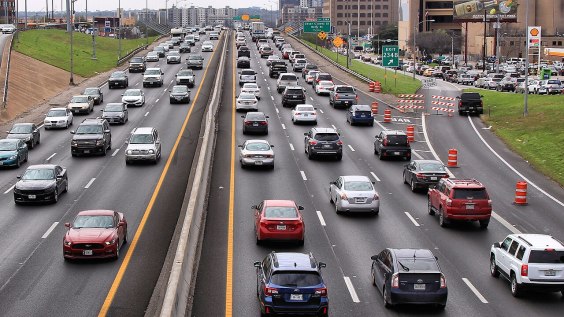Without question, Portland's Greenstreets program is the benchmark for American cities seeking to manage storm water and runoff from the street level before it enters the sanitation system pipes. Now, San Francisco is on its way to constructing its first on-street stormwater facilities in two places in the Bayview and Visitation Valley, pilots that should be instructive for the city going forward with the Better Streets Plan.
Leland Avenue in Visitation Valley, which is already under construction, adopts various green-street treatments along the four-block commercial stretch that is being re-designed. Primarily an effort to revitalize business along the corridor, the Leland Avenue redesign incorporates some innovative treatments, including planted bulbouts, permeable pavers and stormwater drainage in parking lanes, high visibility crosswalks, and connections to the city's greenway network.
The Planning Department's Andres Power lauded the Leland Avenue improvements, and said the reconstruction of the street was the first step in a process the city hopes will
become codified in every street redesign moving forward through the Better Streets Plan. He pointed to a new project, however, in neighboring Bayview as the benchmark for how San Francisco is innovating street design. Power is the project manager for the Model Block pilot on Newcomb Avenue in the Bayview, a project designed around stormwater treatment. The Newcomb project is situated on the 1700 block, just off of 3rd Street between Newhall and Phelps, and will employ a cocktail of street treatments, including stormwater planters and bulbouts, planted traffic calming chicanes, permeable pavement at on-street parking spaces, landscaped sidewalks that absorb runoff, raised crosswalks, and new street trees.
"Newcomb will be the first true green street in San Francisco," said Power, who noted that over the last few years movement from within the city on these matters has been quite positive. "From a policy and design perspective, there has been a sea change; it
is infinitely easier to be able to talk about this stuff. Good design feels much less like an impossibility."
The cost to remake the Newcomb is $1,251,421, half of which comes from the San Francisco Redevelopment Agency, nearly $500,000 from the U.S. EPA, and the remainder from San Francisco Mayor's Office of Housing Community Challenge Grants. The Redevelopment Agency, as part of the expansion of its Model Block single-family home rehabilitation program, will provide financial assistance to low-income families on Newcomb in conjunction with the renovation to refurbish their dwellings.
San Francisco is clearly looking to Portland for inspiration (several photos in Newcomb Avenue brochures are from the City of Roses), though pressures and stresses on this city's sanitation system are quite different from Portland, as Rosey Jencks of the San Francisco Public Utilities Commission (PUC) pointed out. Jenks said San Francisco invested in large storage facilities under the Great Highway and the Embarcadero in the 1980s to prevent sewage overflows into the bay. Also unlike Portland, San Francisco's controlled combined sewage system has the capacity to deal with almost every storm that comes its way.
"Our drivers are different," said Jencks, referring to the Clean Water Act lawsuit that compelled Portland to clean up the Willamette River. "We don't have rivers with Salmon in them and we addressed the Clean Water Act with storage facilities. We're in full regulatory compliance."
Jencks said the storage facilities brought raw sewage overflows into the bay and ocean down from an average of more than 80 per year before adding the tanks to fewer than 10 a year currently, most of those small. But, she acknowledged, "The public is not happy with combined sewage overflows any time," so her agency is working with Planning, the Department of Public Works, and the MTA to address upstream storm water through street design. Jencks noted that any reduction in storm water entering their facilities saves the city money by reducing pumping and processing volumes.
Looking forward, Planning's Power highlighted the Cesar Chavez Street redesign, which is slated to begin construction in 2010. Power said Caltrans awarded a $250,000 grant to the Planning Department to begin planning charettes for the Highway 101 interchange at Cesar Chavez, commonly known as the "Hairball," and the portion of Cesar Chavez that stretches from 101 east to 3rd Street. Furthermore, the U.S. EPA just awarded the $6 million project an additional $1.2 million for greenstreet treatments from the Hairball west to Guerrero Street. The EPA grant doubled the funding that had been planned for greenstreet facilities and gives the project leaders the opportunity to make the street the showcase for green design citywide.
"From a planning perspective we're moving to make sure all street projects have these treatments," said Power. "It hasn't been part of the standard approach in the city, but the Better Streets Plan will change that."
UPDATED: 11/19, 9:43 a.m.







